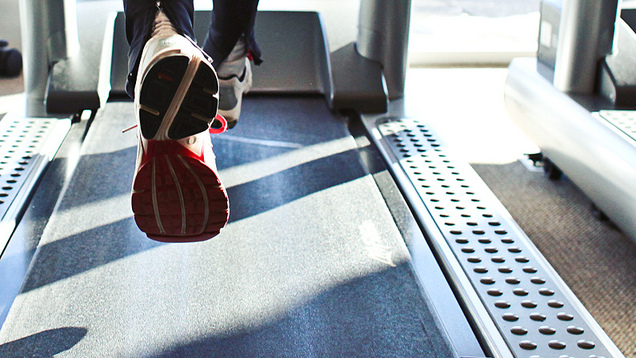Is a treadmill workout really equivalent to running outdoors? Some runners say it’s easier because the belt does some of the work for you, or that you always need to run at a 1% incline to simulate an outdoor effort. Neither of these are totally true.
Photo by E’Lisa Campbell
Biomechanics expert Casey Kerrigan tells Runner’s World that if you’re running seven-minute miles on a track, you would encounter wind resistance, and adding a 1% incline to your treadmill will help make your indoor effort more realistic. For those of us who run slower, though, an incline isn’t necessary.
What about the idea that the belt helps you by pushing your feet? Clearly, from a physics standpoint, it doesn’t matter whether it’s the runner or the ground that is moving (thanks relativity) but the myth persists. Kerrigan’s team had to publish a study debunking it in Medicine & Science In Sports & Exercise to convince funders at the National Institutes of Health that the biomechanics of treadmill and overground running are similar. They write in the paper that their results “should put to rest the notion that treadmill running lacks push-off”.
Read the rest at Runner’s World, including Kerrigan’s own treadmill workout tips.
Biomechanics Expert Debunks Treadmill Running Myths [Runner’s World]

Comments
3 responses to “Treadmill Physics: Why An Indoor Run Isn’t Cheating”
I prefer a treadmill run because I can maintain focus, rather than having to dodge potholes, animals, cyclists and old people.
I can generally run harder and longer on a treadmill, so even if it’s easier in theory, I’m still pushing myself to my limits, so it really doesn’t matter.
Can’t say I’ve ever felt like working harder with road vs treadmill or vice versa.
There are advantages to running outside, such as being able to alter pace (rather than have the machine dictate it). And running on a treadmill gets really boring after a while.
I prefer a treadmill because it’s constant. As mentioned, you don’t need to run around obstacles, wait for lights, etc, but I will agree it’s ‘easier’ in the sense that I’d choose running in an air-conditioned gym over summer pavement in Sydney, every day of the week.